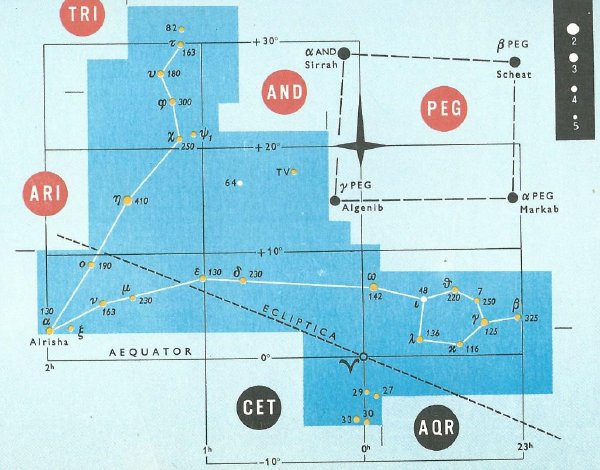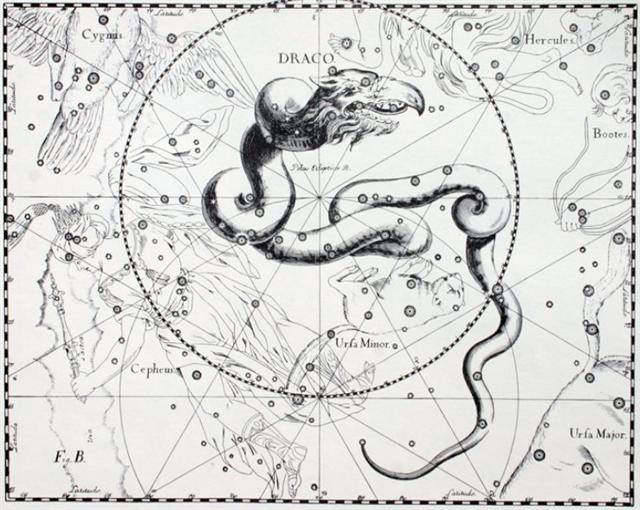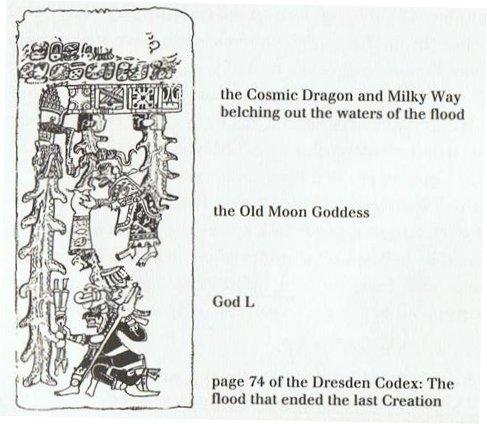|
29
Once again. Dzaneb (ω Piscium) was not at 0h, instead it was Sirrah in the 3rd corner of the Pegasus Square which was at 0h.
Heliacal Polaris at the end of side a on the C tablet would have been at *29 (= *26 + *3) if counted from Dzaneb. And in a way time could have stood still so to say for 29 days from March 18 (*362, Dzaneb) to April 16 (80 + *26 at Polaris). From Dzaneb (*362) to Sirrah (0h) there were 3 days, which we can compare with 3 days from γ¹ Octantis (*361.4) to θ Octantis (364.4):
... Another name for Mercury was Hermes and Hermes Trismegisthos (thrice-mighty) could have referred to the fact that there were 3.141 * 115.88 = 364.0 days for the cycle of the Earth around the Sun. Although the calendar has 365 days for a year this is due to the fact that the Earth has to turn around an extra day in order to compensate for how the direction to the Sun changes during a year ... In the G text θ Octantis has evidently been placed at Gb6-25 in the day preceding Sirrah:
... Ecclesiastically, the equinox is reckoned to be on 21 March (even though the equinox occurs, astronomically speaking, on 20 March in most years) ... However, counted from the beginning of the G text at heliacal Ain (Ga1-1) ... The letter name is derived from Proto-Semitic *‘ayn-, eye, and the Phoenician letter had an eye-shape, ultimately derived from the jr hieroglyph ... To this day, ‘ayin in Hebrew, Arabic and Maltese means 'eye' and 'spring' (‘ayno in Neo-Aramaic) ... we will find heliacal Sirius first at Ga2-7 (1 + 36 = 37) and then once again at Gb6-20:
Which suggests a reorientation could have taken place from *360 (Gb6-21) to Gb6-26 (*365): ... Nut, whom the Greeks sometimes identified with Rhea, was goddess of the sky, but it was debatable if in historical times she was the object of a genuine cult. She was Geb's twin sister and, it was said, married him secretly and against the will of Ra. Angered, Ra had the couple brutally separated by Shu and afterwards decreed that Nut could not bear a child in any given month of any year. Thoth, Plutarch tells us, happily had pity on her. Playing draughts with the Moon, he won in the course of several games a seventy-second part of the Moon's light with which he composed five new days. As these five intercalated days did not belong to the official Egyptian calendar of three hundred and sixty days, Nut was thus able to give birth successively to five children: Osiris, Haroeris (Horus), Set, Isis and Nepthys ...:
Or we could say there were 6 dark nights 'with sleeping mats' which ended at March 22 (*366) at the 4th and last corner of the Pegasus Square, viz. at Algenib.
From the First Spout (Al Fargh al Mukdim) at Scheat (β Pegasi) in March 5 (31 + 28 + 5 = 64) to Algenib (γ) in March 22 there were 17 days - possibly alluded to at March 17 - the date named Liberalia by the Romans. 17 = 16 + 1 → 171 = 161 + 10: ... Midsummer is the flowering season of the oak, which is the tree of endurance and triumph, and like the ash is said to 'court the lightning flash'. Its roots are believed to extend as deep underground as its branches rise in the air - Virgil mentions this - which makes it emblematic of a god whose law runs both in Heaven and in the Underworld ... The month, which takes its name from Juppiter the oak-god, begins on June 10th and ends of July 7th. Midway comes St. John's Day, June 24th, the day on which the oak-king was sacrificially burned alive. The Celtic year was divided into two halves with the second half beginning in July, apparently after a seven-day wake, or funeral feast, in the oak-king's honour ...
Quicksilver (the metal connected with the Mad Hatter) has been found in the foundations of great ancient pyramids. ... Mercury was used in the process of curing pelts for hats, making it impossible for hatters to avoid inhaling the mercury fumes given off during the hat making process; hatters and mill workers thus often suffered mercury poisoning, causing neurological damage, including confused speech and distorted vision ... Confused speech and distorted vision characterized both hatters and those who worked at the mill (like a merry-go-round). ... Snorri Sterluson explains why 'Frodi's grist' is a kenning for gold. Frodi ruled during a peaceful and productive period, contemporaneous with Augustus's Pax Romana and the birth of Christ; hence the kenning. There were neither thieves nor robbers during this period, 'so that a gold ring lay long on Jalang's heath'. Snorri continues his account with the legend of the mill beyond what is told in the song: The girls' grinding produced an army hostile to Frodi. On the very day of the girls' predictions, the sea-king, Musing (Son of the Mouse), landed on the Danish shore, killed Frodi, and took away Grotti and the women on his ship. The girls were bidden to grind out salt on the mill. At midnight they asked for further instructions. 'Keep grinding', he told them. Then they ground with such vigor that the ship sank. Water poured into the eye of the mill, creating the maelstroem of the sea. Therefore the sea was salt. Incidentally, the mill was given a kenning, Serpent's Couch ...
The last page in the Dresden Codex is number 74, which we now can guess could be referring to Sirius (*465) in the day before March 16 (75 = 31 + 28 + 16). Here the confused emperor of China was bound to draw his bow towards the Celestial Jackal:
|
||||||||||||||||||||||||||||||||||||||||||||||||||||||||||||||||||||||||||||||||||||||||||









.jpg)

